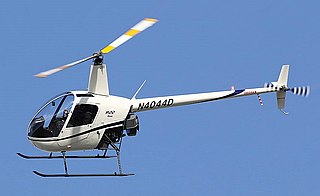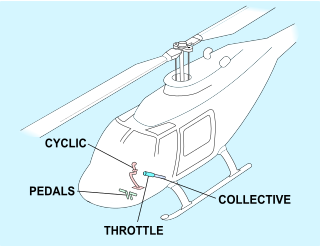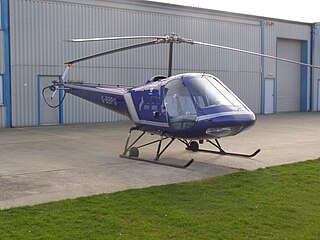The Robinson Helicopter Company, based at Zamperini Field in Torrance, California, is an American helicopter manufacturer. As of 2024, Robinson produces three models: the two-seat R22, the four-seat R44, both of which use Lycoming piston engines, and the five-seat R66, which use Rolls-Royce turbine engines.

The Robinson R22 is a two-seat, two-bladed, single-engined, light utility helicopter manufactured by Robinson Helicopter Company. It was designed in 1973 by Frank D. Robinson, and has been in production since 1979.

The Robinson R44 is a four-seat light helicopter produced by Robinson Helicopter Company since 1992. Derived from the company's two-seat Robinson R22, the R44 features hydraulically assisted flight controls and a larger engine. It was first flown on 31 March 1990 and received FAA certification in December 1992, with the first delivery in February 1993.

Helicopter flight controls are used to achieve and maintain controlled aerodynamic helicopter flight. Changes to the aircraft flight control system transmit mechanically to the rotor, producing aerodynamic effects on the rotor blades that make the helicopter move in a desired way. To tilt forward and back (pitch) or sideways (roll) requires that the controls alter the angle of attack of the main rotor blades cyclically during rotation, creating differing amounts of lift at different points in the cycle. To increase or decrease overall lift requires that the controls alter the angle of attack for all blades collectively by equal amounts at the same time, resulting in ascent, descent, acceleration and deceleration.

The Schweizer S300 series family of light utility helicopters was originally produced by Hughes Helicopters, as a development of the Hughes 269. Later manufactured by Schweizer Aircraft, and currently produced by Schweizer RSG, the basic design has been in production for over 50 years. The single, three-bladed main rotor and piston-powered S300 is mostly used as a cost-effective platform for training and agriculture.
Time between overhauls is the manufacturer's recommended number of running hours or calendar time before an aircraft engine or other component requires overhaul.

Toledo Suburban Airport is a public use airport located two nautical miles southwest of the central business district of Lambertville, a city in Monroe County, Michigan, United States. It is located just north of Michigan's border with Ohio and northwest of the city of Toledo, Ohio. It is included in the Federal Aviation Administration (FAA) National Plan of Integrated Airport Systems for 2017–2021, in which it is categorized as a general aviation facility.

A helicopter is a type of rotorcraft in which lift and thrust are supplied by horizontally spinning rotors. This allows the helicopter to take off and land vertically, to hover, and to fly forward, backward and laterally. These attributes allow helicopters to be used in congested or isolated areas where fixed-wing aircraft and many forms of short take-off and landing (STOL) or short take-off and vertical landing (STOVL) aircraft cannot perform without a runway.

The Schweizer 330 and S333 are turbine-powered developments of the Schweizer 300 light piston-powered helicopter. As of 2007, only the Schweizer 333 remains in production. In February 2009, the 333 was rebranded as the Sikorsky S-333. In 2018 the Schweizer R.S.G. bought the Schweizer Aircraft from Sikorsky Aircraft and it was rebranded as Schweizer S333 again.

The Enstrom Helicopter Corporation is an American helicopter aerospace manufacturer, based at the Menominee–Marinette Twin County Airport in Michigan, United States.

The Enstrom F-28 and 280 are a family of small, light piston engine powered helicopters produced by the Enstrom Helicopter Corporation.

The Enstrom 480 is a small, light helicopter produced by the Enstrom Helicopter Corporation.

The Robinson R66 is a helicopter designed and built by Robinson Helicopter Company. It has five seats, a separate cargo compartment and is powered by a Rolls-Royce RR300 turboshaft engine. The R66 is slightly faster and smoother than the piston-powered Robinson R44 from which it is derived. The R66 received both type and production certificates from the U.S. Federal Aviation Administration (FAA) on October 25, 2010. The R66 is a larger and turbine powered derivative of the Robinson R22 and R44 family of helicopters.

The Flettner Fl 185 was an experimental German gyrodyne developed by Anton Flettner, a machine which could fly both as a helicopter and as a gyroplane.

The Sikorsky S-434 is a light, turbine-powered helicopter. The S-434 is an improved development of the Schweizer S333.

The Guimbal Cabri G2 is a two-seat light helicopter produced by Hélicoptères Guimbal, and powered by a reciprocating engine. Designed by Bruno Guimbal, a former Eurocopter engineer, it had its origins in the 1980s, and the first demonstrator flew in 1992. Following the granting of regulatory approval, the Cabri entered commercial service in 2008. In addition to its use within the general aviation sector and as a training rotorcraft, the Cabri G2 has also been used as the basis for unmanned aerial vehicles (UAVs).
The RotorWay Helicopter Manufacturing Company, formerly called RotorWay International, was a manufacturer of kit helicopters located in Chandler, Arizona, United States. The company was founded by B.J. Schramm in 1961 as RotorWay Aircraft. RotorWay International was bought February 14, 2007 by a small group of investors comprising the company's upper-level management – Grant Norwitz, CEO, Bill Adams, COO, and Judy Craven, CFO. Of these, only Norwitz was still with the company in mid-2008.
The Spitfire Mark I was a utility helicopter built in the United States in the late 1970s and intended for series production. In essence, the Mark I was an Enstrom F-28 that was modified to use an Allison 250 turboshaft engine and geared transmission in place of the original piston engine and system of vee belts. The resulting powerplant installation was lighter and more compact, which allowed for additional cargo or fuel.
Menominee Regional Airport is a public use airport located 1 mile (2 km) northwest of the central business district of Menominee, Michigan, a city in Menominee County, Michigan, United States. It is included in the Federal Aviation Administration (FAA) National Plan of Integrated Airport Systems for 2021–2025, in which it is categorized as a local general aviation facility.

The VRT 500 is a project of a light helicopter with a coaxial rotor developed by VR-Technologies (VRT), a subsidiary of Russian Helicopters.















